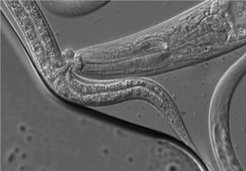Ralf Sommer
Integrative Evolutionary Biology
Max Planck Institute for Biology Tübingen
Faculty in: TIPP, IMPRS

Vita
- Diplom in Biology 1989, RWTH Aachen & University of Tübingen
- PhD work 1989-92 at the Ludwig-Maximilians University Munich
- Research fellow 1993-95 at CALTECH, Pasadena, USA
- Director at the MPI since 1999
- Adjunct Professor, University of Tübingen since 2002
Research Interest
My primary scientific interest is to unravel the mechanisms that give rise to evolutionary alterations and novelty. We use an interdisciplinary approach that integrates development, ecology and population genetics. We study the nematode Pristionchus pacificus, which we have established as a model system. P. pacificus combines laboratory studies building on forward genetic, CRISPR-engineering, genomic and transgenic tools with field work. A core aspect of our current research is developmental plasticity, a concept that has recently received a lot of attention as a facilitator of phenotypic diversity.


Available PhD Projects
- Currently not recruiting PhD students
Selected Reading
- Lightfoot, J. W., Wilecki, M., Roedelsperger, C., Moreno, E., Susoy, V., Witte, H. & Sommer, R.J. (2019): Small peptide mediated nematode self-recognition prevents cannibalism. Science, 364, 86-89, doi: 10.1126/science.aav9856.
- Lightfoot, J. W., Dardiry, M., Kalirad, A., Giaimo, S., Eberhardt, G., Witte, H., Wilecki, M., Roedelsperger, C., Traulsen, A., & R. J. Sommer, R.J. (2021): Sex or cannibalism: polyphenism and kin recognition control social action strategies in nematodes. Science Advances, 7, eabg8042.
- Sieriebriennikov, B., Prabh, N., Dardiry, M., Witte, H., Rödelsperger, C., Röseler, et al. (2018): A developmental switch regulating phenotypic plasticity is a part of a conserved multi-gene locus. Cell Report, 23, 2835-2843, doi: 10.1016/j.celrep.2018.05.008
- Ragsdale, E., Müller, M., Roedelsperger, C. & Sommer, R. J. (2013): A developmental switch coupled to the evolution of plasticity acts through a sulfatase. Cell 155, 922-933, doi: https://doi.org/10.1016/j.cell.2013.09.054
- Bento, G., Ogawa, A. & Sommer, R. J. (2010): Co-option of the hormone-signalling module dafachronic acid–DAF-12 in nematode evolution. Nature 466, 494-497, doi: 10.1038/nature09164
- Renahan, T., Lo, W.-S., Werner, M. S., Herrmann, M., Rochat, J. & R. J. Sommer (2021): Nematode biphasic ‘boom and bust’ dynamics are dependent on host bacterial load while linking dauer and mouth-form polyphenisms. Environmental Microbiology, 23, 5102-5113, doi: 10.1111/1462-2920.15438
- Renahan, T. & R. J. Sommer (2021): Nematode interactions on beetle hosts indicate a role of mouth-form plasticity in resource competition. Frontiers in Ecology and Evolution, 9:752695.
Sun, S., Witte, H. & Sommer, R. J. (2022): Chitin contributes to the formation of a feeding structure ina predatory nematode. Current Biology, 33, 1-13. doi: 10.1016/j.cub.2022.11.011
Featured in: Woodruff, G. C. (2023): Developmental genetics: The structural basis of malleable teeth. Current Biology, 33, R106-R108.Lo, W.-S., Han, Z., Witte, H., Röseler, W. & R. J. Sommer (2022): Synergistic interaction of gut microbiota enhances the growth of nematode through neuroendocrine signaling. Current Biology, 32, 2037-2050. doi: 10.1016/j.cub.2022.03.056
Featured in: MacNeil, L.T. (2022): Microbiomes: How a gut bacterium promotes healthier living in a nematode. Current Biology, 32, R428-R430.


